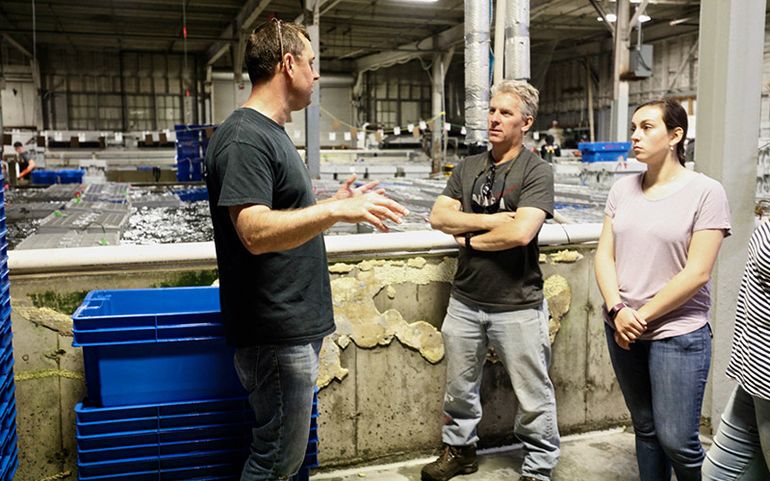
Saint Joseph's contributes to research on improving survivability of shipped lobsters
 Courtesy / Patricia Erikson
Marine biologist Curt Brown of Ready Seafood shows the company's lobster holding tanks to Steve Jury and Katie Pelletier of Saint Joseph's College. According to Annie Tselikis, director of the Maine Lobster Dealers Association, the position of lobster biologist at a private seafood company is unique in the Maine lobster industry.
Courtesy / Patricia Erikson
Marine biologist Curt Brown of Ready Seafood shows the company's lobster holding tanks to Steve Jury and Katie Pelletier of Saint Joseph's College. According to Annie Tselikis, director of the Maine Lobster Dealers Association, the position of lobster biologist at a private seafood company is unique in the Maine lobster industry.
An academic and industry collaboration is looking into ways to create an environment where a “soft shell lobster” can be turned into a more resilient and valuable “hard shell lobster” after it has been trapped.
Since soft shell lobsters aren’t resilient enough to be shipped overseas, the goal is to boost the export market with more hard shell lobsters.
Saint Joseph’s College’s sciences department, the University of Maine and Ready Seafood, a live and processed lobster wholesale company in Portland, are collaborating on the two-year project funded by the Maine Technology Institute Technology Asset Fund.
Earlier this year, MTI awarded Ready Seafood with $2.25 million toward a $6 million “Maine lobster full utilization campus” project. Of that, nearly $100,000 was set aside to support scientific research in the laboratories of Steve Jury and Lucas Bernacki of Saint Joseph’s College in Standish and Rick Wahle of University of Maine in Orono. The research is designed to increase the lobster fishery’s value by improving scientific understanding of the physiology of lobsters that will improve their survival rates during live shipping.
This past summer, the Saint Joseph’s team manipulated holding tank conditions in the college’s wet lab and then tested lobster “hemolymph” — the fluid similar to blood in humans — to measure the impact on their protein levels.
“By understanding how lobster physiology responds to modifying salinity and ion chemistry of their holding tank water (as well as to different types of feed supplements), there may be a way to influence their health and improve their shipping survival rates,” Jury said in a news release. “They ship better if specific hemolymph protein levels are higher. Early results of our research are encouraging.”
Tackling the 'soft shell' problem

Reached by phone, Jury explained that determining the stage of a lobster’s shell can be done by manipulating different locations on the shell, such as the body, carapace, claw or tail.
“You can squeeze it and, once you’ve done it thousands of times, you can characterize it as Category A, Category B or hard shell,” he said.
Another way is to clip the swimmerets on the bottom of the tail to see the amount of shell that’s growing and thus determine which stage of molt the lobster is in. Category B is a softer shell and Category A is a harder shell that’s becoming a hard shell lobster. Although Category B is softer, it’s not the paper-thin shell that lobster initially develop right after molting.
“You never see those in the market,” he said of the softest lobsters. And fishermen rarely find them in their traps, because the creatures are vulnerable to being eaten, so they hide out.
Jury said the project came about when he, Brown and Wahle began hashing out the idea at a lobster conference in 2017.
In the release, Brown said, “Given that Maine’s largest export fishery is reliant on volume, it’s a good time to invest in projects that help to maximize the value of this fishery. You cannot just put any lobster on a plane to Rome or Shanghai.”
“The preliminary data look good,” Jury said of the summer trials. “We haven’t solved the problem yet.”
Shipping trials to begin in 2019

Lobsters are trapped by fishermen at various levels of hardness, he said. Typically, they go into holding tanks for a period of time before distribution. The question is whether the manipulation of salinity, ion chemistry and feed supplements in the holding tank water can hasten the shell’s hardness and make the lobster more able to deal with the stress of shipping, he said.
The past summer’s trials tested 100 to 200 lobsters at the Ready Seafood facility.
“Some of the treatments showed significant physiological effect,” he said. “But we need to test those in shipping trials.”
Shipping trials will likely begin in spring 2019, he said, noting the trials will start with simulated shipping on a small scale.
Still to be determined is how the process, if successful, can be scaled up throughout the industry, said Jury.
Soft shell lobsters have been the subject of a Maine Lobster Marketing Collaborative campaign that brands the meat for its sweet taste and has been connecting the industry with high-end chefs to expand the domestic live-lobster market. However, because of their soft shells, the lobsters are difficult to transport long distances.
The value of lobster landed in Maine was $533.1 million in 2016 or nearly 80% of the landed value of all fisheries in the state.













Comments